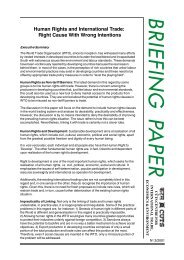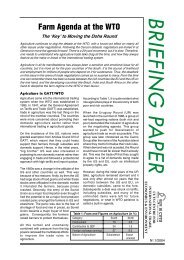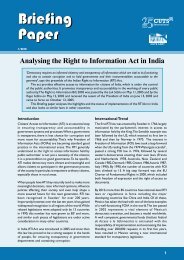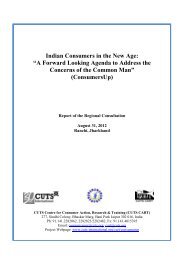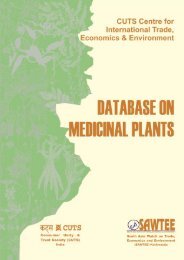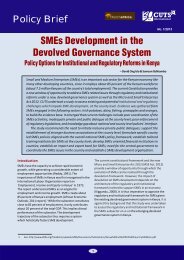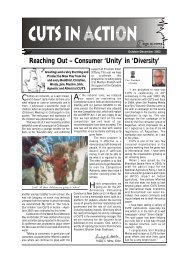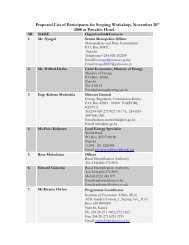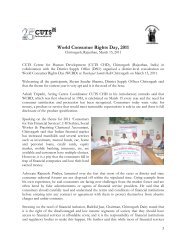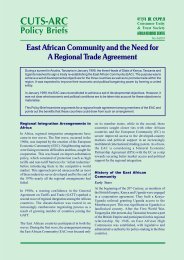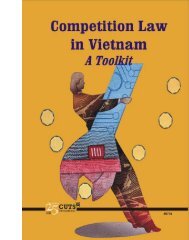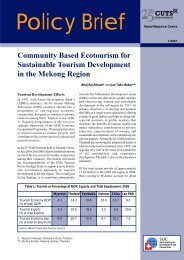Final Report - World Trade Organization
Final Report - World Trade Organization
Final Report - World Trade Organization
You also want an ePaper? Increase the reach of your titles
YUMPU automatically turns print PDFs into web optimized ePapers that Google loves.
competition law doesn’t frown so much on market<br />
power in the ‘traditional’ sense, but rather on<br />
‘personal’ or ‘family’ market power. 92 The existence<br />
of ‘traditional’ market power is also prohibited, but<br />
the law provides that such power is justified if it<br />
contributes substantially to efficiency, or technological<br />
progress or the growth of exports. 93 The question is<br />
whether this approach still adequately reflects the<br />
needs of Pakistan or the current economic reality.<br />
Dominance<br />
As stated above, all of the other countries take a<br />
two-step analysis in assessing abuse of dominance.<br />
First, they have to establish that a position of dominant<br />
market power actually exists. In order to do this the<br />
competition authorities must first define the ‘market’.<br />
This market is not simply the entire world-market<br />
for all products. The authorities must determine what<br />
is the ‘relevant’ market. The relevant market has,<br />
mainly, two dimensions: a ‘geographical’ dimension<br />
and a ‘product’ dimension. 94<br />
The geographical market could generally be the entire<br />
territory of a country or any part thereof. For some<br />
purposes it could even extend beyond the territory<br />
of a country. 95 In Sri Lanka, however, in order to<br />
determine market power (the existence of a<br />
monopoly) the supply of goods or services by one or<br />
the same person has to be of a prescribed percentage<br />
of all those goods supplied in Sri Lanka. 96<br />
To define the ‘product’ dimension the FTC Act takes<br />
a similar approach. The products and services have<br />
to be identified and gazetted by the Government to<br />
fall under the purview of the law’s monopoly rules. 97<br />
If a product is not detailed in the Gazette the Fair<br />
Trading Commission cannot intervene. In such cases<br />
the Commission does not even get around to applying<br />
the second step. This test requires that the<br />
Commission has to prove that the monopoly is against<br />
the ‘public interest’. 98<br />
The laws of the other countries (Kenya, India, South<br />
Africa, Tanzania and Zambia) do not have such clear<br />
description of the ‘relevant’ market. India’s new<br />
Competition Act is the only competition law (although<br />
not yet in force) that provides the competition<br />
authority with specifications as to which factors to<br />
take into consideration when determining the relevant<br />
market. 99 In other 7-Up countries these factors will<br />
simply have to evolve on a case-by-case basis in<br />
order to do justice to both the flexibility needs of their<br />
economies and the need for reliability of the law for<br />
the enterprises.<br />
After the relevant market (both geographical and<br />
product) is determined, the next step is of course to<br />
find out whether or not a dominant position of market<br />
power exists. All these project countries have adopted<br />
a ‘behavioural’ approach 100 towards dealing with<br />
monopolies or dominant enterprises. Nevertheless,<br />
in analysing the existence of dominance they still rely<br />
heavily on the ‘structural’ approach, since the major<br />
factor to take into consideration is the size of an<br />
enterprise’s market share.<br />
The South African law stipulates that a firm is<br />
considered to be dominant if its market share is at<br />
least 45 percent. If the firm’s market share is between<br />
35 and 45 percent there is a presumption of<br />
dominance that is to be rebutted by the enterprise in<br />
question. The law provides that an enterprise can<br />
still be dominant if its market share is lower than 35<br />
percent, but in that case the onus is on the competition<br />
92 For establishing the existence of such power the MRTPO sets a threshold that considers an undue concentration of economic power<br />
to exist if the assets of an undertaking amounts to or exceeds 300 million Pakistani rupees. Public companies are excluded from this<br />
threshold. See CUTS, 2002, Competition Regime in Pakistan - Waiting for a Shake-Up, section 4.2.3 for more on this.<br />
93 CUTS, 2002, Competition Regime in Pakistan - Waiting for a Shake-Up, section 4.2.4.<br />
94 The relevant market can also have a ‘functional’ and ‘temporal’ dimension, but since none of the 7-Up countries include these in<br />
their analysis, these dimensions are not dealt with here.<br />
95 See infra section 4.3.3 on mergers and acquisitions and section 4.3.4 on extra-territorial jurisdiction.<br />
96 This ‘prescribed’ percentage is set by the Minister for Internal and International <strong>Trade</strong> and Food and is considered a rather arbitrary<br />
cut off point that varies between 40 and 50 percent. Also see CUTS, 2002, Towards a New Competition Law in Sri Lanka, chapter<br />
4 for more on this. The Sri Lankan FTCA also covers monopsonies since a monopoly is also deemed to exist if a prescribed<br />
percentage of all supplied goods or services are supplied to one and the same person. FTCA, Clause 12.<br />
97 Currently there are 47 identified and gazetted products and services with prescribed percentages applicable to section 12 of the FTCA.<br />
98 See CUTS, 2002, Towards a New Competition Law in Sri Lanka, section 4.1.1 for more on this.<br />
99 Indian Competition Act, 2003, Clause 19 (6) and (7).<br />
100 Under this approach monopolies or dominant positions are not prohibited per se, but should refrain from certain business practices<br />
that renders them against the public interest.<br />
Pulling Up Our Socks w 37



